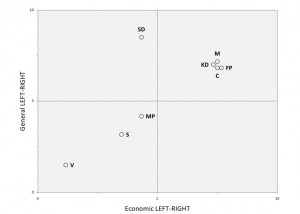One of the things that I am trying to do with this blog is to show how theories of comparative politics can help us understand and interpret current political events. My two previous posts, for example, have drawn connections between Sweden’s December Agreement and Katz and Mair’s concept of the cartel party and Johnston & Brady’s ideas of party collusion. I’ve also implicitly drawn on arguments developed by rational choice theorists, such Downs, McKelvey, and Schofield, in making the point that Sweden’s parties now occupy a multidimensional political space — and that this fundamentally changes the nature of Swedish politics. It’s a point that I think Giovanni Sartori would agree with.
In his 1976 classic, Parties and party Systems, Sartori argued that there were essentially three main types of party systems: the two-party system, moderate pluralism, and polarized pluralism. The differences between the two-party system and moderate pluralism were essentially organizational, that is, parties merely organized themselves differently in the two systems. The two-party system was characterized by two large, moderate catch-all parties. The moderate plural party system was characterized by two blocs of parties, with parliamentary coalitions emerging from one bloc or the other. Electoral strategy was contingent on these arrangements — two-party politics was based on broadcasting general appeals; moderate pluralism encouraged “narrow-casting” to segments of the electorate. But these differences did not fundamentally alter the fact that politics was broadly unidimensional in nature, running along the traditional left-right cleavage. The game was thus largely about converging on the median voter, either in the electorate (the two-party system) or in the legislature (the moderate plural system).
Polarized pluralism looked and operated very differently, however. Certainly, multipartyism is a defining feature of polarized pluralism — but the parties are not arranged in blocs in unidimensional left-right space; rather some parties sustain themselves by adopting extreme positions on certain cross-cutting issues. There are strong centrifugal ideological forces in polarized pluralism, and these centrifugal forces place great pressure on the centre parties. What can emerge is a vicious cycle of government instability, policy paralysis, irresponsible opposition, and populist frustration, and sometimes democratic collapse – think Weimar Germany, Allende’s Chile, or the French Fourth Republic. Those are dramatic and extreme possibilities; more often elites manage the situation by diluting the force of electoral politics – think the of the perpetual Red-Black grand coalitions of post-war Austria: hey, you can have any government you want provided it’s Social Democrat – Christian Democratic coalition.
I see a lot of evidence of this pattern taking hold of European politics. Sweden is just one example: the Swedish Democrat’s electoral success indicates the extent to which the old-two bloc model of Swedish politics is crumbling, and the Agreement itself is indicative (in my view) not of regime stability, but of the brittleness of the parliamentary environment. Sure Sweden’s main parties can claim that they have delivered stability and kept undesirables from the levers of power, but in so doing they’ve limited the number of bases on which governments can be built and colluded to stifle debate on key issues (not just on immigration – mind you; read the Agreement). This in turn undercuts the Rikstag’s capacity to function as a representative forum, encourages the Swedish Democrats to engage in irresponsible opposition, and fuels the very populism on which the Swedish Democrats rely. The December Agreement, in short, is a technocratic solution to a liberal democratic crisis. The EU specializes in this sort of endeavour, and well…
Similar patterns are emerging in the UK (as evidenced not just by UKIP’s success, but by the long-run decline in Conservative and Labour vote shares and an increasingly tenuous agreement about Britain’s role in Europe and indeed UK’s territorial and constitutional integrity), Greece (where both the far-left and far-right are gaining ground), France (Je suis Charlie, the FN etc.), and Germany (the disintegration of the FDP and the rise of the AfD and Pegida). Europe is entering an era of polarized pluralism.

 Follow
Follow